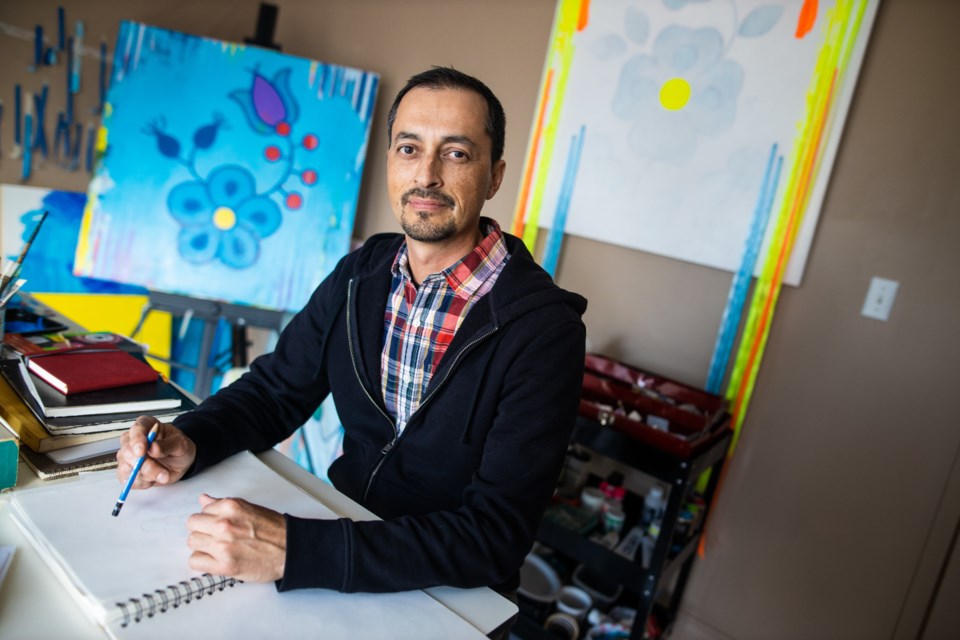Motivated by the devastating impact of aggressive oil and gas exploration and extraction in indigenous territories, a Black Diamond artist is sharing a vital message with the stroke of his paintbrush.
Bruno Canadien’s bold, multi-media collages adorned with ribbon, images of wildlife, news clippings and acrylic paints represents his distress over resource exploration in the universal language of art.
“I want to bring up questions and get people thinking about the effects of the consequences of certain actions,” said Canadien. “These issues aren’t going away and I don’t see any reason why I should become apathetic.”
Canadien’s art depicts these harmful effects through obvious techniques like his collages to more subtle messages like acrylic flowers on canvas adorned with colourful ribbons, inspired by his Dené roots.
“I get really political and show the harmful industrial extraction in indigenous territories, but I also do this floral-based work which is more of what I’m working towards right now,” he said. “It still talks about industry and its impact and indigenous sovereignty, but it’s more subtle. I’m coming at it from a more personal viewpoint in my new work.”
Creating these portrayals conjures up mixed emotions for Canadien.
“When you’re dealing with those kinds of issues, frustration plays a part and that’s motivation for making the work, but while I’m working I’m enjoying the process,” he said. “It allows me to think about those ideas of community and relationship to the land, and how that relationship is expressed on one hand and also affected by outside forces like industrial activity.
“I’m enjoying putting paint down, putting colour down, making marks, creating texture. I can work through those feelings, those ideas. That brings me joy.”
While Canadien spent his childhood drawing in the rich indigenous culture of Fort Providence, a hamlet in the South Slave Region of the Northwest Territories, his subject matter often represented pop culture.
“My grandmother and mom and sisters would all make traditional artwork like beading and moose hair tufting,” he said. “As far as being involved in the culture, I appreciated what was around me but it didn’t make its way into my art until later.”
It came to the forefront while Canadien attended the Alberta College of Art, now the Alberta University of the Arts.
“As an indigenous person in a mostly non-native space, you’re sort of looked at to educate others,” he said. “People naturally ask questions and want to know about your background. There may have been some assumptions that I was more aware of my indigenous culture or just any indigenous culture just because I was indigenous.”
Canadien internalized that and took it upon himself to delve into his heritage artistically.
“I think most contemporary indigenous artists and their work are political — it's unavoidable considering indigenous people are a political category and have the burden of the federal government's constant oversight and control,” he said. “As artists, it's our job to reflect back society and our lives, so our art becomes about identity, colonial systems, the land, health, family.”
Canadien also engaged in the occasional protest, including the Idle No More movement in 2012, that opposed certain types of resource exploitation, and (MISSING WORD??>) round dances in Calgary malls.
“Being indigenous, being political is just sort of what happens to you,” he said. “You want to show your support for your community.”
While in college, Canadien met such inspirational artists as Joane Cardinal Schubert, Carl Beam and Jane Ash Poitras, further propelling his work into a more cultural realm.
“I started these small collage-based acrylic paintings in my last year and it turned out that that was my taking off point for the body of work that I created outside of college,” he said. “That work was about recognizing and honouring indigenous existence to specific indigenous resistance to acts of invasion and resource extraction. For me, it was about being aware of our situation and what’s happening in Canada.”
For his graduation piece, Canadien painted sun symbols with the names of indigenous leaders on 60 sheets of oversized Mayfair paper.
“I did paintings of angry suns that were about recognizing indigenous leaders that had led endeavours to make things better for people,” he said. “I was moving into that direction at the end of my fourth year. While I was in college I became more aware and educated about indigenous art and history.”
Upon graduating with a major in painting, Canadien remained focused on indigenous art. With help from Cardinal Schubert, his work was exhibited through the Calgary Aboriginal Arts Awareness Society.
“I slowly built up my art practice and focused on my visual vocabulary while, at the same time, taking whatever opportunities there were to do public presentations and shows and exhibitions,” he said.
In 2008, Canadien’s series of map-based paintings, representing decolonizing the landscape by removing colonial and opposed borders and highlighting contemporary indigenous communities, was exhibited in the Honouring Tradition: Reframing Native Art exhibition in Calgary’s Glenbow Museum.
“When you look at a world map these days you wouldn’t be able to pick out a First Nations community,” he said. “They’re made invisible on regular maps. This was my way of making them visible.”
In 2013, Canadien’s quadratic piece, Pipe Dreams, was featured in the Art Gallery of Alberta’s Alberta Biennial of Contemporary Art, featuring bright acrylic paint on canvas adorned with black ribbons and cloth to represent oil.
Canadien’s more recent work depicts the more subtle traditional floral images.
“Floral imagery is used in all sort of mediums, mostly to embellish clothing,” he said. “To me, Dené floral energy represents the love for the land and community and family.”
Outside of his Black Diamond art studio, Canadien’s love of the land is evident through his community involvement as a member of the parks and recreation committee and Sheep River Library board, as well as co-founder of Project Green Day, an annual community cleanup initiative.
To learn more about Bruno Canadien go to brunocanadien.com




